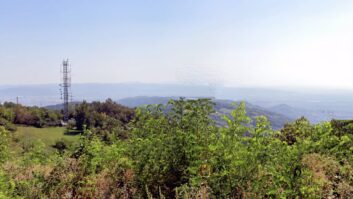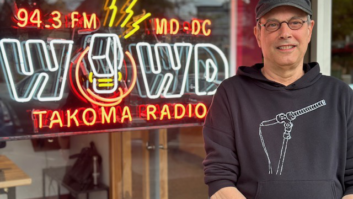KUNC: Decades on the Mountain Airwaves
Sep 1, 2011 1:30 AM, By Larry Selzle
After its years of evolution, KUNC settles into its new home serving Colorado’s eastern plains and mountain communities.
As the 1960s came to a close, KUNC began broadcasting as a 10W student station on the campus of the University of Northern Colorado. By the mid 1970s, the station had evolved into a Class A, 3kW station, and was Colorado’s first radio station to become a member of National Public Radio. The early 1980s KUNC became a Class C1 station. It was during this period that KUNC began to grow its network of translator stations in order to serve listeners on Colorado’s eastern plains and in the mountain communities.

The talk studio and control room during KUNC’s summer drive.
For most of my career, I worked for commercial stations in Colorado and Wyoming, but in 2000 was hired as chief engineer for KUNC. In early 2001, the University of Northern Colorado announced that they had reached an agreement with Colorado Public Radio, a statewide public radio network in Denver, to purchase the station. This agreement needed approval from the UNC Board of Trustees. An open meeting was held the next day. Impassioned KUNC supporters pleaded with the Trustees to give them time to raise money in order to buy the station. The trustees relented, and gave KUNC supporters less than a month to submit a counter proposal. A local group organized and raised more than two million dollars to buy the station and retain KUNC’s local independence. Community Radio for Northern Colorado was born in March 2001, with the first order of business to move off campus. KUNC settled into a high-rise office building in downtown Greeley, CO. In 2007, KUNC moved its main transmitter from a site north of Greeley to Buckhorn Mountain, just west of Fort Collins, CO. This move added nearly one million people to KUNC’s city-grade 60dBu coverage area, which includes the metro Denver area.
Just the right size
In early 2010 our lease in the downtown high-rise office building was about to expire and KUNC needed more room. The building owners could not fulfill our needs, which prompted a search for a new space. We wanted to find a location that had enough room for present needs and future growth, and a space that required very little remodeling. Engineering also had specific needs, including good line of site to the transmitter for the STL, and enough space with an unobstructed southerly look angle for KUNC’s 3.7m satellite downlink and 2.4m satellite uplink. After careful consideration, the perfect location was found. An accounting firm previously occupied KUNC’s new home. It had offices just the right size for studios, equipment and staff members. It also had a number of rooms that could be easily remodeled and soundproofed for studios, great line of site to the transmitter and ample room for the satellite antennas. The new location also had its own walk-in entrance, plenty of parking for staff and guests, and a great view of Colorado’s Front Range Mountains to the west. It had everything KUNC was looking for! The lease was signed.

The talk studio and control room during KUNC’s summer drive, from the talk side (Jamie Wood and Neil Best pitching, Erin O’Toole producing).
KUNC looked at quite a number of options when considering equipment needs. The old location had an on-air studio, a fully equipped production studio, and another small, very basic production studio. We looked at all of the different console manufacturers, with the need to completely equip four studios. Budget was also a consideration. KUNC had been using the Revolution console made by Arrakis for our on-air studio since moving from the UNC campus in 2000. This console has been an extremely reliable workhorse with very few problems over its 10 years in service. A quick check of the Arrakis catalog revealed this console still in production. The Revolution console has 12 analog and 12 digital inputs, as well as a host of other features including solid mix-minus buses for the telephone hybrid and a modular design with a separate console engine for ease of installation. Best of all, the Revolution console cost less than many of the competitor’s analog-only consoles. It was a real value! The decision was made to equip all four of KUNC’s new studios with the Revolution console. Three new consoles were purchased and the on-air console from the old location was moved to the new studios. The producers and on-air folks all like working with the Revolution consoles. They particularly like that they all look and operate the same.
– continued on page 2
KUNC: Decades on the Mountain Airwaves
Sep 1, 2011 1:30 AM, By Larry Selzle
After its years of evolution, KUNC settles into its new home serving Colorado’s eastern plains and mountain communities.
Audio routing

Talk studio control room with talk portion on the other side of the glass
The next question is: How do we get the audio around the facility? The old studios used traditional analog distribution networks. This meant we needed a lot of shielded cable between the studios. Modern studios use audio routers and other technologies to accomplish this. After investigating a number of options, I decided the Arrakis Aarc-Net audio networking system was a good fit.
The folks at Arrakis really had their thinking hats on when they came up with Aarc-Net, teaming with AudioScience for a very practical, workable and affordable design. Many systems in the field today are custom, one-of-a-kind designs and are manufactured for a particular console manufacturer. AAarc-Net, on the other hand, uses non-proprietary Cobranet technology distributing digital audio to nodes located in each studio and in the equipment room via Ethernet over a single, standard CAT-5 cable. A number of configurations are available from Arrakis. KUNC’s system has four analog inputs and outputs, and four digital inputs and outputs per node in each of the four studios and the equipment rooms. Audio from any of the five nodes can be routed to any or all of the other nodes on the network. The system can also be expanded when future needs arise. Aarc-Net is compatible with any console from any manufacturer, analog or digital. Arrakis worked closely with KUNC on the design for our studios. Its location in Loveland, CO, just a few miles away from the KUNC studios, was also a plus.

Main on-air studio
Other equipment
Another key component for any studio design is the studio furniture. KUNC engaged the services of Graham Studios, another local business based in Ft Collins, CO. Rod Graham is one of the most talented designers in the business. He is also one of the finest individuals you will ever work with. Graham Studios makes quality custom designed furniture for the broadcast and recording industry that is shipped worldwide. He designed all of KUNC’s studio furniture.

Production room B
– continued on page 3
KUNC: Decades on the Mountain Airwaves
Sep 1, 2011 1:30 AM, By Larry Selzle
After its years of evolution, KUNC settles into its new home serving Colorado’s eastern plains and mountain communities.

All audio originates or is routed to the equipment room and distributed to the other studios. Satellite receivers, uplink modem, Arbitron encoder and monitors, ISDN, EAS and air monitoring, audio processing, STL, etc, are all located in the equipment room.
The rest of the studio equipment includes Electro-Voice RE-20 mics, DBX 286S processors, Telos One hybrids, O.C. White booms, BE Audio Vault automation, Studiohub SHHP headphone amplifiers, Moseley SL9003Q STL, numerous XLR and 1/4″ connectors, RJ-45 crimps, some punch blocks as well as shielded and non-shielded CAT-5 cable. KUNC had very few problems with the move. Some obstacles included securing all of the necessary permits, but that goes with any move. Another problem was getting the STL antennas properly aligned to deliver a strong enough signal for KUNC’s nearly 40-mile shot to Buckhorn Mountain. We also had to dig up the parking lot for cabling and electrical service to the satellite antennas. But it all paid off. At 7 p.m. on Saturday, Nov. 6, 2010, KUNC began broadcasting from our brand new studio!
Equipment list Arrakis Aarc-Net, Revolution
AudioScience ASI2416
Broadcast Electronics AudioVault
DBX 286S
Electro-Voice RE-20, RE27N/D
Graham Studios furniture
Moseley SL9003Q
O.C. White mic booms
Radio Systems StudioHub+
Tascam CD01U
Telos One
Selzle is chief engineer of KUNC, Greeley, CO.
More Photos

Another view of the talk studio.

Larry Selzle in the equipment room.

The STL antenna mounted on the roof.
Contributor Pro-File: Larry Selzle
This month: Larry Selzle; Chief Engineer; KUNC; Greeley, CO…
September 2011
Managing audio assets, inside KUNC, a preview of the 2011 Radio Show, Field Reports on the Avid Mbox Mini and Harris Oasis and more….












